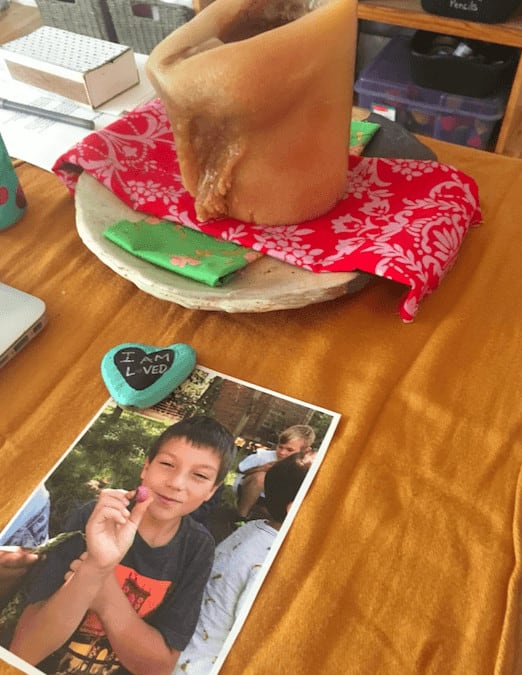
by West | Oct 16, 2017 | Blogs, News, Rainbow Institute
The words of American spiritual teacher and author Ram Dass encourage us to live FULLY, in the present moment, without judgement. How do you achieve this? What practices do you embrace?
“Be Here Now” for example, calls on mindfulness practice.
“The quieter you become, the more you can hear” invites stillness.
“The heart surrenders everything to the moment. The mind judges and holds back” summons your love.
As individuals on our own unique spiritual journeys, we are always looking for inspiration that may guide our inner work. Ram Dass’s wisdom offers insight and intention that may aid in cultivating a heightened self-awareness. We know that an elevated self-awareness has the capacity to lead to meaningful and enduring relationships.
RCS is founded on meaningful relationships.
The relationship between the teacher and the learner is the heart of education and a parent is a child’s first teacher. Rainbow honors that and strives to communicate with parents compassionately and empathetically, learn from the parent, see the child from through many lenses, support the child holistically and bridge home life and school life. One of the many ways these relationships are nurtured is through meaningful and intentional conferencing. Rainbow sets aside a conference time in early September called Listening Conference. During this conference the faculty calls upon self awareness by practicing the skills of deep listening.
Deep Listening is a way of hearing in which we are fully present in the moment without judgement or control. Deep listening asks us to let go of our inner dialogue, pre-formed opinions and assumptions, challenges us to abstain from crafting a response and simply listen in a mindful and respectful way to what is be shared. This is a time to be attentive not reactive, to listening actively not passively, to embrace compassion and empathy, AND to bring a great self-awareness to the act of listening.
To do this effectively requires that our mind takes a backseat to our heart.
Each conference embraces these powerful questions: Can we develop a practice of listening that allows another person to find their next step? Can we become the birthplace of understanding for someone else? Can we learn to carry in our hearts the destinies of others?
Each conference opens with a sacred ritual. Teachers may light a candle, read a reflective quote, hold space for silence, lead a guided mediation and/or offer a prompt with the purpose of inviting the child’s spirit to the conversation.
How can what we do at RCS inspire your own personal or professional work? What if we practiced deep and mindful listening in our everyday lives, what if we always invited spirit in to the conversation?
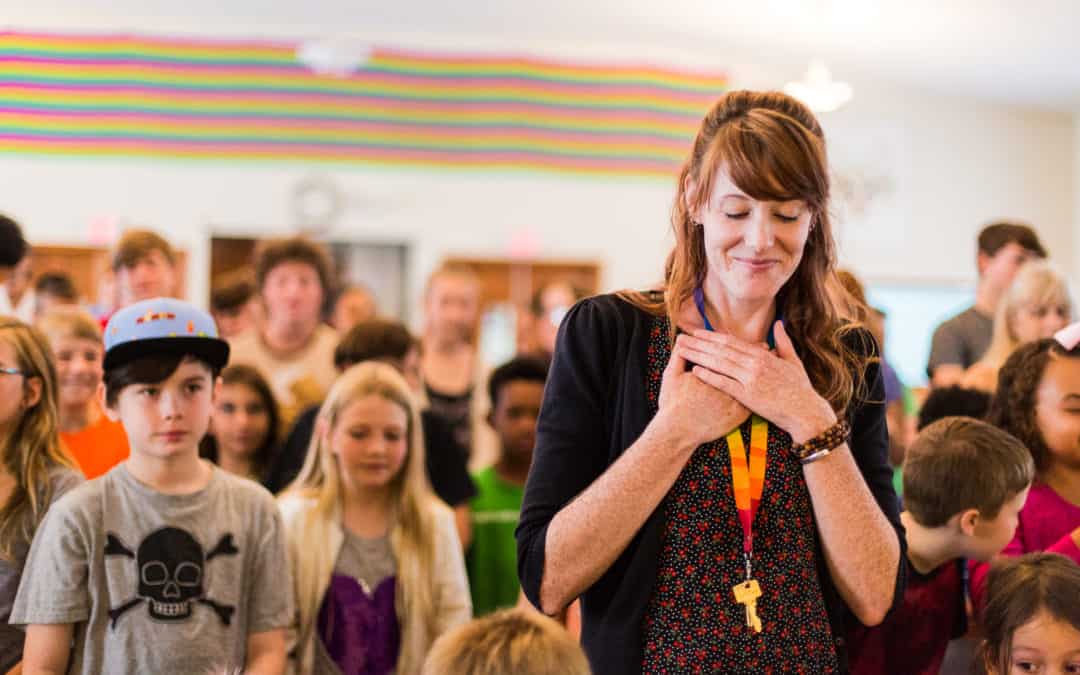
by West | Oct 16, 2017 | Blogs, News, Rainbow Institute
Fall is here and fall break has likely come and gone for many of us. This season often brings a lot of transition for our students. These transitions are embedded in the rhythms of the natural world, the energy around celebrations and holidays, and within the refection and personal goal setting that emerges from the start of each school year.
With this in mind, I invite you to stop for a moment and imagine the experience of a child as he transitions from home to school after just one night, a weekend, or a long holiday.
Maybe you imagined the hustle and bustle as he arrvied- the classroom filled with stories, sharing, reconnection and laughter. Or maybe you imagined the groggy, sleepy child, dragging his feet and resisting the weekday routine. Or even the child emerging from a car ride full of screen time. Maybe you witnessed a child arriving hungry without a proper dinner and/or breakfast. Or a child who is sleep deprived due to long working hours from the previous. Or even a child who is managing some sort of trauma in his life. Regardless, the classroom you imagined was likely flooded with 20+ learners holding varying levels of energy, focus, fuel, and general centeredness. As educators, we recognize the importance of holding space for all those varying energies but for also fostering a culture of centeredness so that all pathways to learning are open.
How do we actively support this transition from home to school each day?
How do we invite a level of awareness or mindfulness for our learners?
How do we foster a sacred intention for learning?
At Rainbow we achieve this through a morning ritual called centering. Ritual is simply defined as a ceremonial act. To that end, our centering practices are ceremonial in nature. During these practices, simple routines are turned into rituals through tone, intention and mindfulness.
First, the hustle and bustle of the morning is calmed and quieted with the ring of a chime or bell. It is amazing how a soft sound can silence a room and even more amazing how silence can invite sacredness into a space. This sound is a reminder to the students that they are about to engage in a sacred ceremony.
Secondly, pausing to take deep breaths together shifts each person’s individual energy into a collective synergy. Then, lighting a candle in silence invites something powerful and even magical into the classroom. This fire also serves as an anchor point for which learners can choose to cast their gaze when reflecting or meditating. Additionally, sending a greeting around the circle or turning to greet a neighbor not only allows each individual to be seen and to be witnessed, but it invites compassion, empathy and mutual respect. Speaking a verse, blessing or word into the circle also supports coherence and connectedness among all class mates. It serves as another reminder that we are on this learning journey together.
These rituals not only help to support the home to school transition, focus each learner, nourish class coherence and synergy, but they remind us that learning is scared.
Rainbow utilizes ritual in other transformative ways; meal blessings, honoring and memorializing people, animals & places, expressions of gratitude and appreciation, blessing ways and other birth and death transitions, rites of passage, communal celebrations all become ceremonial acts.
How can what we do at RCS inspire your own personal or professional work?
Can you replace a daily routine with a ritual by adding a mindful presence to it or by enhancing it with ceremony?
Try creating ritual for your classroom, organization and/or home?
Here is a brief list of simple rituals:
A gratitude exercise, a silent nature walk, quote reflection, a daily song/ verse or blessing, a visualization, read a daily story with a virtue/ moral, draw and/or color a mandala, borrow/adapt a ritual from a particular culture/religion, create nature art, give affirmations to friends and family members, practice mudras, yoga, qigong, or a martial art, and daily journaling.
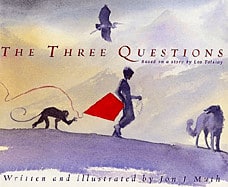
by West | Sep 12, 2017 | Home Page News, Rainbow Institute
Daily centering practice is a part of every Rainbow classroom. These practices, although all anchored in the Rainbow Spiritual Domain Learning Outcomes, take on many shapes and forms and evolve based on the learning needs of the children and the passions of the teacher. From journaling, meditation, dance, yoga, creating art, team building, time in nature to mindfulness practices… regardless of their format, this is a special time where children are encouraged to find their center and their source of personal power and wisdom before undertaking the lessons and explorations of the day.
Oral myth or story often set the stage for a centering or in many cases a children’s book can serve as inspiration for a particular theme. In each RCS classroom you will certainly find a bookshelf designated for those special “centering books.” One that touches the heart of many is Jon. J. Muth’s The Three Questions. This book is an illustrated adaptation of a story by Leo Tolstoy in which a young boy Nikolai, goes on a quest to find the answers to these three questions.
What is the best time to do things?
Who is the most important?
What is the right thing to do?
Nikolai’s interaction with various characters inadvertently lead him into the answers to those three questions.
If the purpose of a holistic education is to nurture the whole child, we do this by aiding them in uncovering their inner wisdom and truest, most authentic self…
As holistic and spiritual educators we explore existential questioning, meaning making, developing connection, leaning into discomfort, encouraging a questing for purpose and embracing awe and wonder.This special book is a gift that has the capacity to do all that for its reader. Happy reading and happy sharing.
Finally, as you gear up for a new school year, new chapter, new job, or just simply a new day. Consider your own three questions. What questions can guide you as you strive to be your best, most authentic self, most divine self?
Maybe these:
What is the best time to do things?
Who is the most important one?
What is the right thing to do?
Or:
What am I doing? Why am I doing it?
Does it bring me joy or purpose?
Is it allowing me to be the best me I can be?
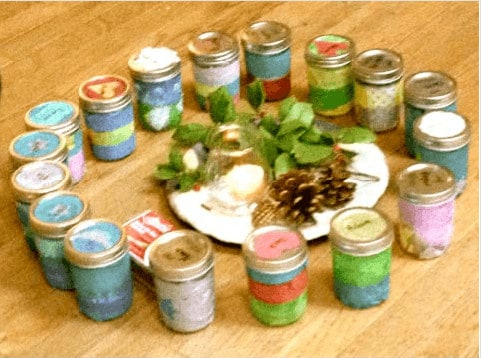
by West | Sep 12, 2017 | Blogs, Home Page News, Rainbow Institute
The beginning of an RCS school year serves as a rite of passage for every student and their classroom community. This time is symbolic of rebirth, renewal, a new beginning- a fresh start. RCS teachers begin by creating a sacred and safe foundation in which the students can explore their role as integral community members. Teachers strive to foster shared ritual and ceremony and aim to nurture a culture that embraces the spiritual virtues such as mutual respect, deep connection, appreciation and gratitude.
Daily centering practices aid the teacher in establishing this culture through themes that are inspired by the various spiritual virtues. For example, fourth graders begin their year by building Gratitude Jars. The purpose of this centering activity is to meditate on the power of gratitude and serve as a model for giving and receiving appreciations. These jars also serve as grounding resources to return to on days that are particularly hard or challenging and/or when a child may need to refocus on a positive energy. “The struggle ends when gratitude begins” ~ Neale Donald Walsch
Our teachers are well aware of the many benefits of cultivating gratitude in their personal lives and in the lives of their students.
Click here for a great article on The 31 Benefits of Gratitude You Didn’t Know About: How Gratitude Can Change Your Life.
This activity is launched by an email to families requesting a personalized gratitude for their child. This can be as simple or complex as a family would like it to be. Once the gratitudes have been collected by the teacher, the students participate in a centering practice in which they create their jars.
The opening of this centering focuses on the power of gratitude and the sacred practice of slowing down and appreciating the special people and experiences in our lives.- maybe by reflecting on a quote about gratitude.
The teacher then explains that the jars will serve as year long collection vessels for various gratitudes and appreciations.The students are then guided to use tissue paper to personalize their jar (It works best if pieces of tissue paper are no bigger than a square inch and applied to the outside of the glass jar with the glue solution) and this introductory centering concludes as they jars are left to dry overnight.
The next day, during a follow up centering, students are again encouraged to meditate on the power of gratitude and are prompted to share in a partnership the following considerations…
Why might gratitude be considered contagious?
What type of energy does gratitude spread?
If gratitude were a color what color would it be and why?
The students regroup and the teacher hands each child their jar (at this point the teacher has secretly placed the family written gratitudes inside each jar). The teacher sets the tone for exploring the jar and encourages the children to use it as a sacred time to personally digest the gift of gratitude from their family. This is not a time when sharing is necessary…instead encourage the students to place the notes back in the jar when finished reading them.
These jars are reintroduced throughout the year with notes from teachers and others students as deemed necessary and appropriate by the teacher.
How can what we do at RCS inspire your own personal or professional work?
Consider these questions…
Why might gratitude be considered contagious?
What type of energy does gratitude spread?
If gratitude were a color what color would it be and why?

by West | Jul 20, 2017 | Blogs, Rainbow Institute
Summer is a breeding ground for travel, adventure, and memory making. Its long days, breaks from school and work, flexible schedules also yield down time, rest, and a chance to turn inward and reflect. Having said this, I share with you an inspiring centering activity that you may wish to add to your summer contemplations.
6th grade coins this centering “Return with the Elixir” and it is often used at the close of a thematic unit, calendar year or school year. It invites students to reflect upon and share their knowledge, strengths and gifts with each other and the larger community. The centering also has an intended purpose to inspire empathy, encourage connectedness and recognize the archetypical human experiences across time and cultures.
It begins by asking the students to examine the hero’s journey map paying special attention to the end of the map, where the hero returns home with the elixir. It continues by explaining that in mythology, this is often literally a magic potion or object. Symbolically, it represents a special knowledge or wisdom to share. Review examples from well-known stories such as Wizard of Oz or Star Wars as well as real-life examples such as Buddha or Jesus Christ.
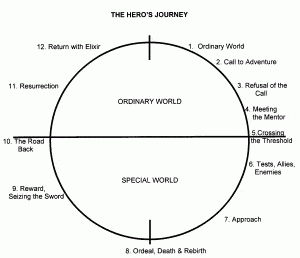
Students are then led in a guided meditation. Asking questions such as…
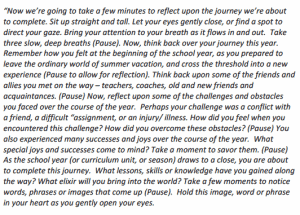
After the meditation, explain that each student will receive a glass vial in which they will put their elixir. This can be a written word, phrase, or image placed on a piece of paper and sealed in the bottle. They may use colored sand, glitter, small pebbles or shells in the bottle to “activate” the magic of their special elixir. Explain that students will work in silence to create space for reflection, but that they will have a chance to share their elixir with their classmates once everyone has completed the task. Hand each student a bottle or vial. As students receive their bottles, they may find a table set up with art supplies and begin working on their elixir bottles. Allow 15-20 minutes for individual work. One by one, have students place their elixir on a windowsill or other central location to symbolize sharing their elixir with the classroom community. Invite students to share a word, phrase or short anecdote that represents their elixir.
Think about your own quests over the summer. You may be on some sort of Hero’s Journey that was met with challenge, obstacle, success, or joy.
How will you overcome them or savor them?
What lessons, skills or knowledge have you gained along the way?
What elixir will you bring into the world?
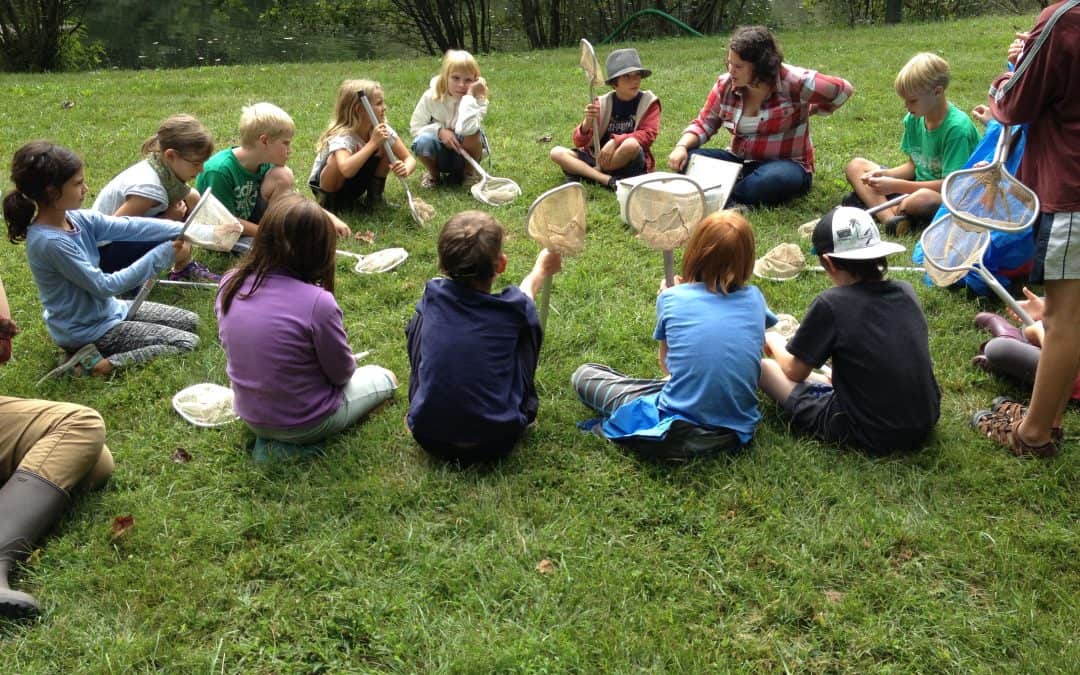
by West | Jul 5, 2017 | Blogs, News, Publications, Rainbow Institute
A culture that is permeated by a materialist philosophy sees the Earth as a commodity- a resource to bought, sold, quantified and controlled. In this view- humans are separate from nature instead of interdependent. Many of the educational methods at Rainbow aim to shift this paradigm by paying homage to the sacred bond between nature and humanity and connecting children to nature on heart and soul level.
Our model and methods have been inspired by educators such as David Sobel. Sobel an educational theorist and author, is most known for his theories on placed based education- in which the local community, culture, landscape, and environment not only become the classroom but also the teachers.
In Sobel’s educational philosophies the natural world plays a central as a teacher. In one of his most famous works, Beyond Ecophobia: Reclaiming the Heart in Nature Education, he explores the learning needs and characteristics of three primary child development stages and likewise, proposes three nature engagement methods. In early childhood, the focus should be on nurturing an empathetic connection towards nature. In middle childhood, nature exploration is emphasized and in early adolescence, stewardship and environmental action takes precedence.
He suggests that this progression not only supports a child’s “biological tendency” to bond with the Earth but fosters “environmentally aware, empowered students” He goes on to state, “if we want children to flourish, to become truly empowered, then let us allow them to love the Earth before we ask them to save it. Perhaps this is what Thoreau had in mind when he said, “the more slowly trees grow at first, the sounder they are at the core, and I think the same is true of human beings.”
Sobel’s work aims to connect children on that heart and SOUL level.
At RCS, Nature is not only a classroom for every student but also plays a central role as a teacher. The Natural World is highlighted in RCS’s mission, vision, guiding principles, and our Rainbow Seven Domains educational method. However, school’s out for summer…BUT we invite you to consider nature as a classroom and a teacher.
Summertime for many children means being outside. Summertime often yields many opportunities to deepen our nature connection- longer days, warmer temperatures, trips to new places, nature hikes, water play, gardening, summer camp, the list goes on. In what ways have you and your family engaged with nature? In what ways has it become a classroom or been your teacher? What have you learned in it and from it?
Now consider your own childhood, how did summertime offer opportunities for a nature connection? Through play, adventure, inquiry and expression? What about deep observation, a cultivation of awe and wonder, what about meaningful relationship and veneration? Most importantly, can you remember a spiritual moment that occurred while in the natural world? These moments in nature can have profound and lasting effects on a child. This connection if nurtured, has the capacity to become intimate, empathetic and sacred. Children can begin to see the natural world as a divine teacher. Therefore it becomes our role as parents, friends, family members, and mentors to hold space- to nurture- to foster that intimate, empathetic and sacred bond.
As you and your family make summer plans for time in nature, consider how you may invite “Nature as divine teacher” along. Embark on your adventures, but pack these considerations with you:
- How can you approach nature with a robust wonder and awe?
- How can you bring a heightened mindful presence to your activities?
- How can you make time for deep contemplation and reflection?
- How can you show gratitude?
















